TheWhoFarm Goes to Schools
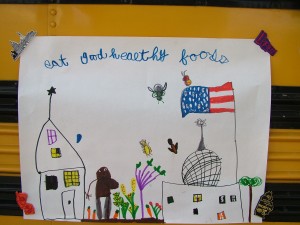
The other night on 6th Street in Austin a guy asked us: “If there is one group your project will help, approved who would that be?” Our answer is children. If our theory proves correct, then the way our president eats and thinks about food will impact younger people for longer and in more profound ways than it will impact any other group of people. The foundations of a healthy diet begin at a young age. If the president is meant to lead and inspire, then a president who eats healthy homegrown food in a publicized way will inspire many young people to eat like the president. And if the president follows TheWhoFarm petition’s recipe by inviting public school students to help garden at The White House, it could drastically change the “edible education” landscape in America.
So, with the interest of children at the forefront of our campaign. we’ve made it a priority to visit schools everywhere we go. And sure enough, kids and their teachers are always receptive.
In Oakland, we parked ourside our friend Jenn Su’s house, Sol. The Sol folks have convinced all the lot owners on the block to allow them to to turn the backyards into a garden. On selected weekends, they invite neighborhood kids over for a gardening lesson. We weren’t around for such a weekend, but Jenn’s housemate Deepa invited us to come to school with her at St. Elizabeth’s.
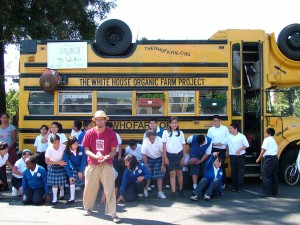
At first, most students seemed more interested in the bus than in our mission. But once we’d let them all trek through the bus, they had a chance to go up to their 2nd story classroom and take a peek at our edible roof. That was the impetus for a good discussion on healthy eating, and the added importance of people who have important decisions to make to eat super healthy. One girl offered us her lunch money so we could buy gas. (We declined. And by the way, contrary to popular belief, unless you have time to make your own fuel, biodiesel is actually more expensive than the regular stuff.) While we were there, a couple of boys were reprimanded for eating avocados without permission. They claimed they’d fallen off the tree, which was apparently pretty unlikely for that time of season. Here’s to hoping avocado snatching is the worst thing those kids ever do.
In Santa Cruz, we stopped by UCSC’s Center for Agroecology & Sustainable Food Systems, “a research, education, and public service program at the University of California, Santa Cruz, dedicated to increasing ecological sustainability and social justice in the food and agriculture system.” The students and apprentices there “get it” completely, and they donated some plants from their farm for our roof.
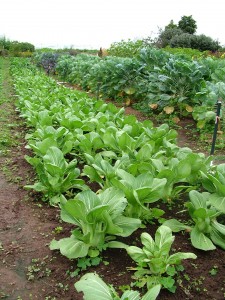
In Ventura, we visited Patagonia’s headquarters. They have an on-site day care center, and while we didn’t make a formal presentation, those kids seemed darn fascinated when TheWhoFarmMobile rolled into the lot. A few parents brought their little ones to look at the bus during lunch time. I wonder who “dragged” who?
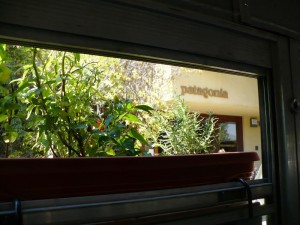
In Los Angeles, our friend Brooke Sparling introduced us to a super high energy fellow named Gabriel, who insisted we stop by Environmental Charter High School. We visited Gabriel’s Green Ambassadors Class, and just about every kid in the class wanted to take a field trip to DC to plant an organic farm on the lawn of The White House. We came pretty close to piling them all in to TheWhoFarmMobile, to head straight for DC. After class, a few kids showed us their gardens. They’d recently planted fruit trees, and hoped that future students would have some organic oranges to snack on. One self-proclaimed “musically gifted” kid told us he’d work on some lyrics for a song about broccoli at The White House.
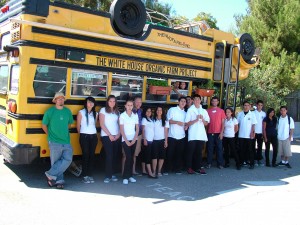
Our journey is happening at a faster pace than we’d sometimes prefer. In Flagstaff, Arizona, we didn’t have time to make arrangements with any school. But on our way out of town, we stopped to check out the New Start Garden that our host Scott Katz had tipped us off to. The garden happened to be adjacent to a high school. I went in to use the restroom. A student opened his classroom door to ask who I was. I mentioned TheWhoFarmMobile, and the teacher’s ears perked up. Class was put on hold, and a quick impromptu discussion on TheWhoFarm ensued in the garden.
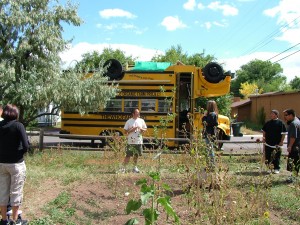
Albuquerque, New Mexico sits on the Rio Grande, which is supposedly the only large river in America used extensively for crop irrigation. As such, most folks seemed quite connected to their food sources. All around town, people grow food in their yards. We were invited to participate in the Carnuel Road Parade, the first, but hopefully not last parade for TheWhoFarmMobile.
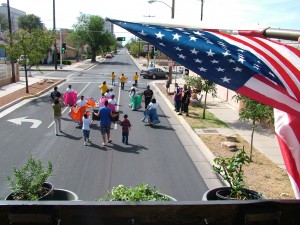
That parade led to an invitation to Escuela del Sol, a Montessori school with an active gardening program. Maria Montessori herself wrote that “When he (the student) knows that the life of the plants that have been sown depends upon his care in watering them…without which the little plant dries up…the child becomes vigilant, as one who is beginning to feel a mission in life.” See: Garden-Based Learning in Basic Education: A Historical Review.) We drank organic lemonade together. Some of the kids articulated their very partisan presidential preferences. At recess, some kids drew pictures they thought we should bring to Washington DC.
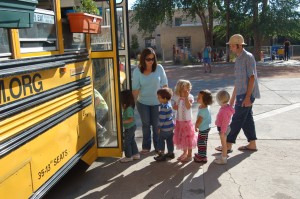
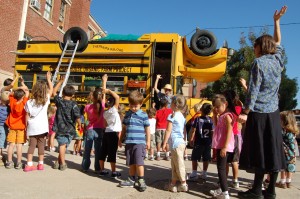
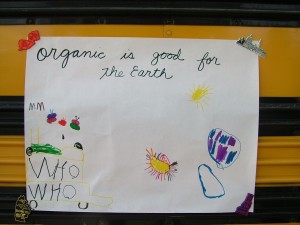
We found out about the 3rd Annual Symposium for Sustainable Food & Seed Sovereignty at the last minute. A group of Mexican farmers who were slated to present had been denied visas, so the conference organizer asked us to take their slot.
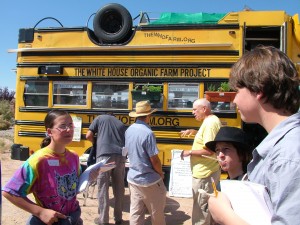
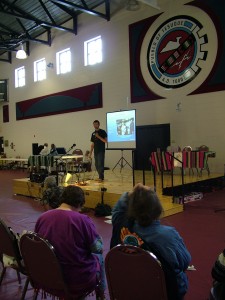
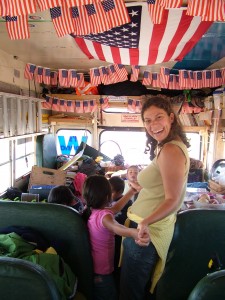
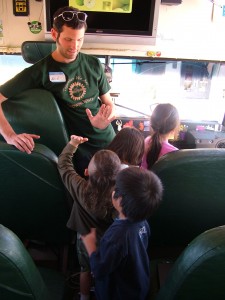
While there, we happened to meet Erin O’Neill, the garden instructor at Monte del Sol Charter School. Erin insisted that we visit. After all, Monte del Sol is an official partner of Alice Waters’ Edible Schoolyard program, which is of course the prime inspiration for TheWhoFarm. After a bumpy ride on Dinasour Road, we arrived just before first Period. I’ve never seen so many kids running TOWARDS a school bus. They nearly banged down our door. We were brought into the gathering space to talk to the entire 7th and 8th grade classes. We asked the students for an example of leadership by example. We were reminded by one student of history that our 40th president proclaimed ketchup a vegetable, and that inspired many many people to put ketchup on everything. A girl named Helena told us she’d make us a poster.
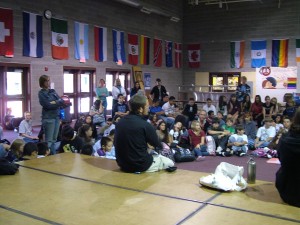
The next period, Nico, the French teacher from France, brought his entire class aboard TheWhoFarmMobile, where we had a very meandering conversation that included a discussion on the differences in the way the French and the Americans eat. (Some of the students had spent the summer in France.) The kids seemed to think that an organic farm on the lawn of The White House would prove to the French that Americans still know a thing or two about food. We apologized for taking the entire period. Nico said that au contraire, he cares just as much about his students learning about life and food as he does that they master French. Perhaps he’ll have them right a French essay about our visit.
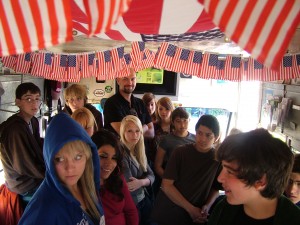
Then it was time for our tour of the Edible Schoolyard, led by a girl called Rose who knew everything there was to know about the garden. Another student said that the garden was her favorite place to read. By then it was time for lunch. We were treated to very healthy portobello wraps that contained greens fresh from the Edible Schoolyard before heading off to Texas.
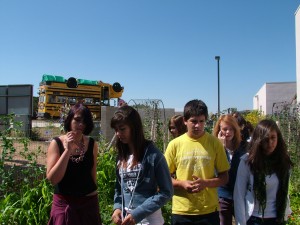
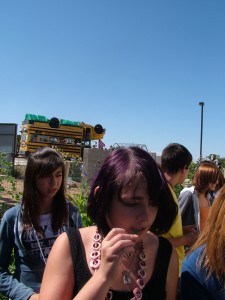
We wish we had more time to visit more schools, and we truly hope that someday soon every school will have a garden on-site, and not just when TheWhoFarmMobile’s edible rooftop garden comes to visit.





